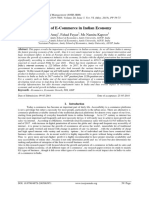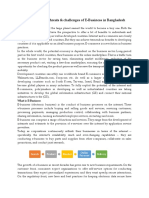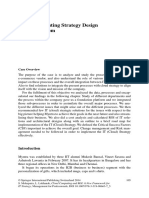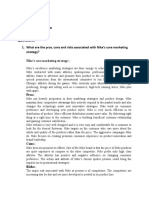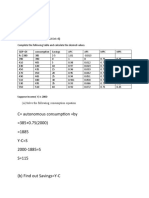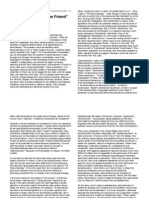The Man Behind e Commerce One by One Profit
The Man Behind e Commerce One by One Profit
Uploaded by
Shahzad HassanCopyright:
Available Formats
The Man Behind e Commerce One by One Profit
The Man Behind e Commerce One by One Profit
Uploaded by
Shahzad HassanOriginal Title
Copyright
Available Formats
Share this document
Did you find this document useful?
Is this content inappropriate?
Copyright:
Available Formats
The Man Behind e Commerce One by One Profit
The Man Behind e Commerce One by One Profit
Uploaded by
Shahzad HassanCopyright:
Available Formats
The man behind e commerce one by one profit
The idea behind this policy is that once the epidemic is eradicated, economic opportunities
will be created and Pakistan must be prepared. To this end, the government is expanding and
increasing production to promote locally produced products to world markets. While many
retailers have already started their e-commerce profit, few take a holistic approach. This is
not enough for long term growth. In order to truly improve, you have to look from
implementation to end and combine process optimization with an understanding of consumer
needs and psychology. As leaders in this field, we bring thoughtful people to all stages of our
e-commerce profit journey for organizations. When your e-commerce business starts to sell,
it's important that you know how much your business will be worth. Oberlo has developed a
simple monthly profit calculator on Google Sheets that you can use to track how much profit
you make on your online store - all you need to do is use a Google account. It's important that
you understand how gross income, net income, and profit are calculated for the job, so we've
broken them down into:
Gross Revenue: You can cover the total revenue of your online store by multiplying the
price by the number of products you sell.
Net Income: To achieve net income, you will first need to multiply the cost for which you
get your product by the number of products your online store sells. When you have filled in
this amount, you will only deduct your result from the total income and you will reach the
monthly income of your ecommerce business.
Profit from Profits: To make a profit from what your store has earned in a month, all
you need to do is deduct your marketing budget from your net income.
E commerce can create 2m jobs, add $40bn to GDP in two year
However, the country still lacks a digital platform for electronic payments. At present, more
than 66% of online payments are made on a cash on delivery (COD) basis, said the president
of RCCI. He said digital transactions accounted for 20% of total transactions in developed
economies, adding that digitization would also have a serious impact on transforming jobs.
He urged the government to rehabilitate banking infrastructure and establish payment
gateways for businesses, retailers, gas pumps, Pakistan International Airlines (PIA), Pakistani
railways, supermarkets, schools and colleges. To encourage the federal cabinet has already
approved an e-commerce policy to promote the transition to a digital economy in order to
increase the volume of trade. The President of RCCI said that the information,
communication and technology sectors in Pakistan should be transformed to transform the
country into a digital economy. He said that digital platforms are developing rapidly around
the world and added that Pakistan needs to develop in this area. He added that mobile phone
access is very high in Pakistan, which has over 160 million mobile phone users and 150
million internet users in the country. E-commerce has the potential to create 2 million jobs in
Pakistan, which could bring the country's gross domestic product (GDP) to 40-40 billion in
the next two years.
You might also like
- HLC Application FormDocument3 pagesHLC Application FormAmey Shelke67% (30)
- 8 Chat GPT Prompts Into 625 Content IdeasDocument15 pages8 Chat GPT Prompts Into 625 Content IdeasNhan su Sach100% (2)
- Am Mxj210226 PDT ProformaDocument5 pagesAm Mxj210226 PDT Proformamalik_saleem_akbarNo ratings yet
- Hi Enmanuel!: Order Confirmation 15T8080Document2 pagesHi Enmanuel!: Order Confirmation 15T8080enmanuel dipugliaNo ratings yet
- PMK 210 Brief English - DraftDocument7 pagesPMK 210 Brief English - DraftAnonymous MNgYrvIC3No ratings yet
- E-commerce Business as a Start Up and Its BenefitsDocument4 pagesE-commerce Business as a Start Up and Its BenefitsebontelearningNo ratings yet
- Assessment: E-Commerce Is Curse or BlessingDocument5 pagesAssessment: E-Commerce Is Curse or BlessingMuhammad ShojibNo ratings yet
- E-Coomerce PolicyDocument18 pagesE-Coomerce PolicySidra ejazNo ratings yet
- Intership Report FinalDocument34 pagesIntership Report Final720721206028 MADHESH DNo ratings yet
- 2016-2020. This Roadmap Highlights The Six Key Areas Emphasized in The APEC DigitalDocument2 pages2016-2020. This Roadmap Highlights The Six Key Areas Emphasized in The APEC DigitalEj LagoNo ratings yet
- (Overview of E-Commerce) : Mohammad Imran Hossain Khandaker 2018511080043Document16 pages(Overview of E-Commerce) : Mohammad Imran Hossain Khandaker 2018511080043Ihk HimelNo ratings yet
- If You Are A Reader of ProfitDocument4 pagesIf You Are A Reader of ProfitMansoor HussainNo ratings yet
- BigbasketDocument48 pagesBigbasketpossess1289No ratings yet
- AE8 - Group1 - Chapter 2Document44 pagesAE8 - Group1 - Chapter 2adarose romaresNo ratings yet
- Impact of E-Commerce in Indian Economy PDFDocument13 pagesImpact of E-Commerce in Indian Economy PDFJayagokul SaravananNo ratings yet
- Impact-of-E-Commerce-in-Indian Economy Case Study PDFDocument13 pagesImpact-of-E-Commerce-in-Indian Economy Case Study PDFakthaks14No ratings yet
- E Commerce IndustryDocument8 pagesE Commerce IndustryRonak PatelNo ratings yet
- E-Commerce and Its Impact On SMEsDocument5 pagesE-Commerce and Its Impact On SMEsSudheera LingamaneniNo ratings yet
- A Synopsis: "E-Commerce Growth in International Market "Document10 pagesA Synopsis: "E-Commerce Growth in International Market "Dee RanaNo ratings yet
- Marketing Strategy of Tata CliqDocument12 pagesMarketing Strategy of Tata CliqUtsav100% (1)
- Boom of Online Business in BangladeshDocument6 pagesBoom of Online Business in BangladeshMD. ISRAFIL PALASHNo ratings yet
- Ecommerce in IndiaDocument8 pagesEcommerce in IndiaSrinivas GotetyNo ratings yet
- Module in EconomicsDocument15 pagesModule in EconomicsAngelico LazalaNo ratings yet
- E-Commerce in Indonesian: Group 8 - Fara Gina (2101051058) - Cristian Hadinata (2101051066) - Intan Nabila (2101051056)Document15 pagesE-Commerce in Indonesian: Group 8 - Fara Gina (2101051058) - Cristian Hadinata (2101051066) - Intan Nabila (2101051056)Fara GinaNo ratings yet
- BD MartDocument26 pagesBD MartJamiur Rahman DourjoyNo ratings yet
- To Print:: Foods Division, Agri-Business Growth Drivers For ITCDocument3 pagesTo Print:: Foods Division, Agri-Business Growth Drivers For ITCraniazharNo ratings yet
- FMCG Sector Industry Analysis FinalDocument10 pagesFMCG Sector Industry Analysis FinalLohith KumarNo ratings yet
- What Went Wrong With Snap Deal?Document77 pagesWhat Went Wrong With Snap Deal?Jeetendar PeswaniNo ratings yet
- Contoh Proposal E-Commerce PDFDocument25 pagesContoh Proposal E-Commerce PDFBella RamadhantiNo ratings yet
- UKMM1043 AssignmentDocument8 pagesUKMM1043 AssignmentYewzzzzNo ratings yet
- E Commerce A Solution To Pakistans Economic WoesDocument27 pagesE Commerce A Solution To Pakistans Economic WoesInciaNo ratings yet
- Unit - 5 EcoomerceDocument43 pagesUnit - 5 Ecoomerceashu mishraNo ratings yet
- MisDocument17 pagesMisAyan SnehashisNo ratings yet
- ProQuestDocuments 2023-10-04Document7 pagesProQuestDocuments 2023-10-04Ahmad AliffaddaNo ratings yet
- Press Release Kota Masa Depan Batch 2Document4 pagesPress Release Kota Masa Depan Batch 2Fahrurozi oziNo ratings yet
- Priciples of Marketing Digital Assignment 2: Name:S.Jayagokul REG NO:19BCC0020Document9 pagesPriciples of Marketing Digital Assignment 2: Name:S.Jayagokul REG NO:19BCC0020Jayagokul SaravananNo ratings yet
- TP BankDocument3 pagesTP BankChi Linh MaiNo ratings yet
- Synopsis On E-CommerceDocument9 pagesSynopsis On E-CommerceVikas0% (1)
- Online Business in The PhilippinesDocument11 pagesOnline Business in The Philippinesjun junNo ratings yet
- Ecomm Essay 1Document3 pagesEcomm Essay 1Agatha JenellaNo ratings yet
- Analysis of E-CommerceDocument24 pagesAnalysis of E-CommerceHashirama SenjuNo ratings yet
- Analysis of Tax Payment Compliance On E-Commerce Transaction in SurabayaDocument12 pagesAnalysis of Tax Payment Compliance On E-Commerce Transaction in Surabayaanderson.andersonNo ratings yet
- E-Commerce Challenges, Solutions and Effectiveness Perspective BangladeshDocument9 pagesE-Commerce Challenges, Solutions and Effectiveness Perspective BangladeshnaimenimNo ratings yet
- History of E-Commerce: Report On Future and Scope of Electronic CommerceDocument5 pagesHistory of E-Commerce: Report On Future and Scope of Electronic CommerceHina AfzalNo ratings yet
- E-Business in BangladeshDocument7 pagesE-Business in BangladeshHimalay HimuNo ratings yet
- Revenue Recognition For E-Commerce RetailersDocument9 pagesRevenue Recognition For E-Commerce RetailersSalma Ramadanti KNo ratings yet
- Snapdeal Report Impact of e Commerce On Indian SMEsDocument36 pagesSnapdeal Report Impact of e Commerce On Indian SMEsPrashantKNo ratings yet
- Disadvantages, Threats & Challenges of E-Business in BangladeshDocument10 pagesDisadvantages, Threats & Challenges of E-Business in BangladeshRahatul TanhaNo ratings yet
- ShopX 05.05.2020Document9 pagesShopX 05.05.2020Akash DherangeNo ratings yet
- E Commarce AssignmentDocument39 pagesE Commarce AssignmentMuhammad A IsmaielNo ratings yet
- News 3 - PEDIDocument2 pagesNews 3 - PEDI2402010110No ratings yet
- E RetailingDocument8 pagesE RetailingMahek AgarwalNo ratings yet
- Bangladesh E-Commerce Booms Beyond Regulatory Oversight BD NewsDocument5 pagesBangladesh E-Commerce Booms Beyond Regulatory Oversight BD NewsVideo GamesNo ratings yet
- Impact of E-Commerce in Indian Economy: Related PapersDocument14 pagesImpact of E-Commerce in Indian Economy: Related PapersxyzhjklNo ratings yet
- Malaysias National ECommerce Strategic Roadmap - Report - V4 - 20-OctDocument45 pagesMalaysias National ECommerce Strategic Roadmap - Report - V4 - 20-OctHadi Al-HadiNo ratings yet
- Retail MarketingDocument16 pagesRetail MarketingUmme HaniNo ratings yet
- Cloud Computing Strategy Design: Case OverviewDocument43 pagesCloud Computing Strategy Design: Case OverviewSergio FonsecaNo ratings yet
- Assignment Mis-207 Name: Sadia Rahman Ritu ID:1812754030 Name: MD Ridwanul Haque ID: 2022340630 Section:15 Date: 05-01-2022Document5 pagesAssignment Mis-207 Name: Sadia Rahman Ritu ID:1812754030 Name: MD Ridwanul Haque ID: 2022340630 Section:15 Date: 05-01-2022Thasin HassanNo ratings yet
- Ek Shop CaseDocument11 pagesEk Shop Casemaruf50% (2)
- Business Plan - The DenDocument19 pagesBusiness Plan - The DenMalik AfshiNo ratings yet
- Information Systems For ManagersDocument4 pagesInformation Systems For Managersritesh nigamNo ratings yet
- 1.what Are The Opportunities and Challenges in Business?: Catetan Tugas Pengantar Bisnis Answers:Minggu Ke 1Document4 pages1.what Are The Opportunities and Challenges in Business?: Catetan Tugas Pengantar Bisnis Answers:Minggu Ke 1Linarahma WatiNo ratings yet
- E Commerce Module16 IA 1103Document3 pagesE Commerce Module16 IA 1103tanimNo ratings yet
- E-Mail: WeaknessesDocument2 pagesE-Mail: WeaknessesShahzad HassanNo ratings yet
- Guidelines For Internship-Summer 2021: Department of Management SciencesDocument2 pagesGuidelines For Internship-Summer 2021: Department of Management SciencesShahzad HassanNo ratings yet
- Letter of ComplaintDocument7 pagesLetter of ComplaintShahzad HassanNo ratings yet
- Role of English in BCDocument7 pagesRole of English in BCShahzad HassanNo ratings yet
- 207165179Document3 pages207165179Shahzad HassanNo ratings yet
- CL Quiz 2Document5 pagesCL Quiz 2Shahzad HassanNo ratings yet
- CL QuizDocument1 pageCL QuizShahzad HassanNo ratings yet
- Functional English: BS PsychologyDocument2 pagesFunctional English: BS PsychologyShahzad HassanNo ratings yet
- Pronunciation TableDocument2 pagesPronunciation TableShahzad HassanNo ratings yet
- COMSATS Institute of Information Technology Course Handbook Research Tool and TechniquesDocument5 pagesCOMSATS Institute of Information Technology Course Handbook Research Tool and TechniquesShahzad HassanNo ratings yet
- What Motivates Me?: The Composer - ISFP PersonalityDocument2 pagesWhat Motivates Me?: The Composer - ISFP PersonalityShahzad HassanNo ratings yet
- How Do Software Developers Understand and Measure Success?Document19 pagesHow Do Software Developers Understand and Measure Success?Shahzad HassanNo ratings yet
- What's My Jungian 16-Type Personality?: Assignment 1 Self-Assessment ExercisesDocument8 pagesWhat's My Jungian 16-Type Personality?: Assignment 1 Self-Assessment ExercisesShahzad HassanNo ratings yet
- Name: Usama Shahid ROLL NO# FA18-BBA-067 (B) DATE:27-4-2020Document4 pagesName: Usama Shahid ROLL NO# FA18-BBA-067 (B) DATE:27-4-2020Shahzad HassanNo ratings yet
- Twelve Angry Men Discussion Questions: Twelve Angry Men Takes Place in A Jury Deliberation Room After The Trial ArgumentsDocument2 pagesTwelve Angry Men Discussion Questions: Twelve Angry Men Takes Place in A Jury Deliberation Room After The Trial ArgumentsShahzad HassanNo ratings yet
- Comsats University Islamabad, Lahore Campus Department of Statistic Sessional II Time: 120minDocument2 pagesComsats University Islamabad, Lahore Campus Department of Statistic Sessional II Time: 120minShahzad HassanNo ratings yet
- Assignment 1 Marketing Excellence Case Study of Nike:-QuestionsDocument2 pagesAssignment 1 Marketing Excellence Case Study of Nike:-QuestionsShahzad HassanNo ratings yet
- Muhammad Kashif Yaqoob - CMS # 404952Document10 pagesMuhammad Kashif Yaqoob - CMS # 404952Shahzad HassanNo ratings yet
- Assignment 1-BDocument1 pageAssignment 1-BShahzad HassanNo ratings yet
- Sp2020 Quiz Ii: COMSATS University Islamabad, Lahore CampusDocument2 pagesSp2020 Quiz Ii: COMSATS University Islamabad, Lahore CampusShahzad HassanNo ratings yet
- COMSATS University Islamabad, Lahore Campus: Sessional 1 - Semester Spring 2020Document3 pagesCOMSATS University Islamabad, Lahore Campus: Sessional 1 - Semester Spring 2020Shahzad HassanNo ratings yet
- COMSATS University Islamabad, Lahore Campus: Final - Semester Spring 2020Document2 pagesCOMSATS University Islamabad, Lahore Campus: Final - Semester Spring 2020Shahzad HassanNo ratings yet
- Ali AdnanECOMMICSDocument2 pagesAli AdnanECOMMICSShahzad HassanNo ratings yet
- C Autonomous Consumption +by 385+0.75 (2000) 1885 Y-C S 2000-1885 S S 115Document2 pagesC Autonomous Consumption +by 385+0.75 (2000) 1885 Y-C S 2000-1885 S S 115Shahzad HassanNo ratings yet
- Assignment 1-BDocument1 pageAssignment 1-BShahzad HassanNo ratings yet
- C Autonomous Consumption +by 385+0.75 (2000) 1885 Y-C S 2000-1885 S S 115Document2 pagesC Autonomous Consumption +by 385+0.75 (2000) 1885 Y-C S 2000-1885 S S 115Shahzad HassanNo ratings yet
- Tome1 1bacsef Math HiyabDocument63 pagesTome1 1bacsef Math HiyabHayat SawatNo ratings yet
- SAE Technical Paper Series (SAE International Aerospace - Neese, W.A. - 1, 1984 Oct 01 - SAE International - 10.4271 - 841505 - Anna's ArchiveDocument16 pagesSAE Technical Paper Series (SAE International Aerospace - Neese, W.A. - 1, 1984 Oct 01 - SAE International - 10.4271 - 841505 - Anna's Archivedyinganaldestroyer1No ratings yet
- SsipDocument14 pagesSsipdhyan shahNo ratings yet
- Rethinking India's FederalismDocument11 pagesRethinking India's FederalismirampeerzadaNo ratings yet
- Rubric For The American Revolution NewsletterDocument2 pagesRubric For The American Revolution Newsletterapi-235470785No ratings yet
- Final Exam RizalDocument1 pageFinal Exam RizalDee-vhine Gee Raposas-Rabut100% (3)
- p380 4 PDFDocument104 pagesp380 4 PDFwillyone4No ratings yet
- Albert Barrow Memorial Comp 2015Document52 pagesAlbert Barrow Memorial Comp 2015Sutanu PatiNo ratings yet
- Short Guide Clinical NutritionDocument30 pagesShort Guide Clinical Nutritiontopiq100% (1)
- Letter To A Japanese FriendDocument4 pagesLetter To A Japanese FriendmbhajianiNo ratings yet
- Antioxidant and Antimicrobial Effects of Grape Pomace ExtractsDocument6 pagesAntioxidant and Antimicrobial Effects of Grape Pomace ExtractsVeronica DrgNo ratings yet
- Identity Assimilation and Church Separat PDFDocument464 pagesIdentity Assimilation and Church Separat PDFAndreiMotoraNo ratings yet
- Economics Project AmanDocument18 pagesEconomics Project AmanAman KumarNo ratings yet
- Fibre To Fabric - MFDocument5 pagesFibre To Fabric - MFMehak FatimaNo ratings yet
- CMA Exam Guide: What Are The CMA Exams, and How To Pass ThemDocument15 pagesCMA Exam Guide: What Are The CMA Exams, and How To Pass ThemFire FactNo ratings yet
- Understanding Metal Stamping - Design To Prototyping To ProductionDocument11 pagesUnderstanding Metal Stamping - Design To Prototyping To ProductionRAKHEE RICHHARIA100% (2)
- Rise of Totalitarianism 11Document26 pagesRise of Totalitarianism 11merimarji6265No ratings yet
- (Desk Research)Document13 pages(Desk Research)Manas Somwanshi100% (1)
- BidyDocument77 pagesBidymiko_53No ratings yet
- A Contrastive Analysis of PunDocument17 pagesA Contrastive Analysis of PunVũ Duy GiangNo ratings yet
- Margie Goldschmidt 2007 Interview Re: Pedophilia, Child Sexual Abuse by Her Husband Mayor/Governor GoldschmidtDocument68 pagesMargie Goldschmidt 2007 Interview Re: Pedophilia, Child Sexual Abuse by Her Husband Mayor/Governor Goldschmidtmary engNo ratings yet
- Dauroh Amali ": Sorogan Fashohah Terjemah Al - Quran FiqihDocument1 pageDauroh Amali ": Sorogan Fashohah Terjemah Al - Quran FiqihJack MaNo ratings yet
- Just A Theory: 7 Misused Science Words Scientific American Pg2Document5 pagesJust A Theory: 7 Misused Science Words Scientific American Pg2Kathleen Clare LeGrasNo ratings yet
- DMA Lecture Doc Thackston PDFDocument146 pagesDMA Lecture Doc Thackston PDFERHANNo ratings yet
- Cover LetterDocument1 pageCover Letterapi-458211409No ratings yet
- The History of Risk Based AuditDocument5 pagesThe History of Risk Based AuditDennis Bacay0% (1)














